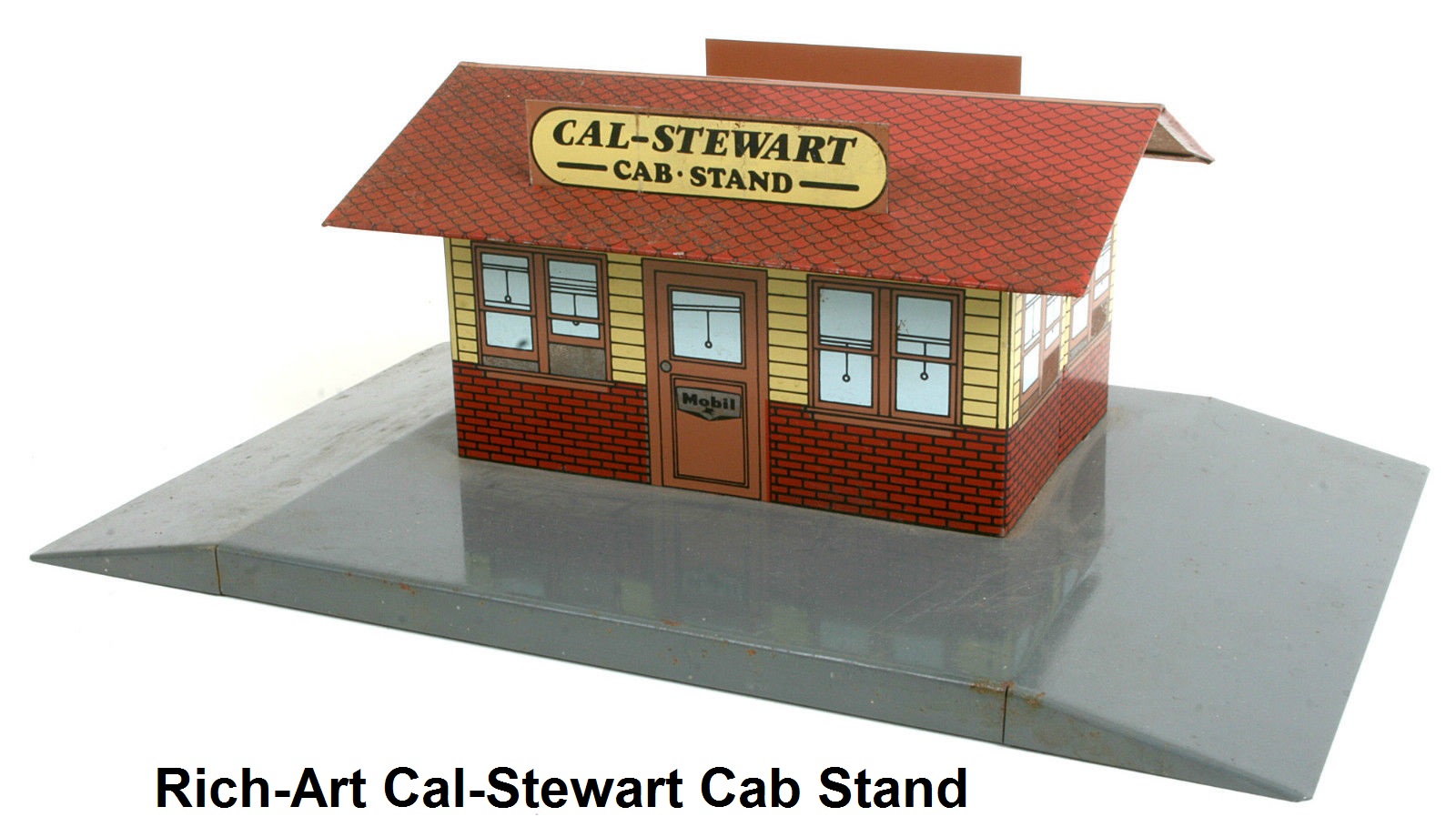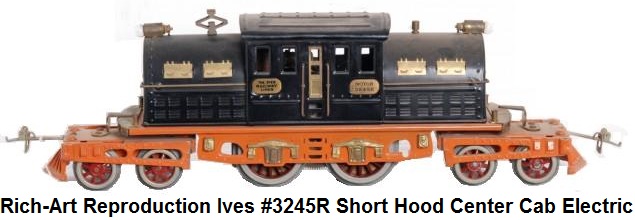 The Rich-Art Company began as a partnership between Dick Mayer and Art Varney for the purpose of building tin-plate
trains and replacement parts. Many of the trains were reproductions of early 20th century Wide
gauge electric trains originally made by the likes of Ives, American Flyer
and 'O' gauge trains by Lionel. The company also developed entirely new
creations in the classic style of tin-plate pre-war trains.
The Rich-Art Company began as a partnership between Dick Mayer and Art Varney for the purpose of building tin-plate
trains and replacement parts. Many of the trains were reproductions of early 20th century Wide
gauge electric trains originally made by the likes of Ives, American Flyer
and 'O' gauge trains by Lionel. The company also developed entirely new
creations in the classic style of tin-plate pre-war trains.
The company, initially known as M & V Enterprises, was started in 1966 when Dick Mayer first got
together with Art Varney. Dick was making parts for Art before then. Their first joint project was an Ives Olympian
engine in wide gauge. In 1970 Dick moved to Northern California, returning to Southern California in 1973 at
which time he re-established his relationship with Art as the Rich-Art company. Dick Mayer eventually settled in
Escondido, CA in 1975 where he maintained the business for the next 37 years and lived the rest of his life.
In the early 1980's Dick's son joined him and they bought out Art Varney's interest in the company. Old school
type methods were used to create the tin-plate parts, and most of the
assembly was done by hand. Classic style machine tools, including many that were built in Germany in
the early 1900's, were utilized to develop the tooling used in machine presses to punch out the
tinplate parts. For raw castings, such as brass boilers, Rich-Art would often contract with smaller
foundries around the country to produce the sand cast molds and castings. Once delivered, these
castings were then machined into the finished parts utilized in the train manufacturing process.
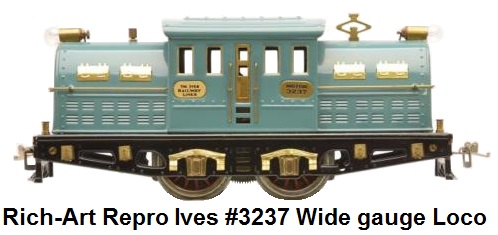 John Richard 'Dick' Mayer was a master tool and die maker. Arthur W. Varney was an incredible sheet metal man.
These combined skills enabled the company to produce top quality toy trains. The products were marked 'TRC'
or with a stylized version of these letters. Mayer and Varney had also manufactured the products of
Varney & Sirus, and John Daniel, as well as many of the early Cal-Stewart
fund-raising items. The company's motto was "Quality reproductions at affordable prices". All products were
completely made in the USA. The special run and unusual items were manufactured in limited quantities.
Dick Mayer also made the tooling and stamped parts for Tom Stephenson of the
United States Toy Train Company (U.S.T.T.C.). U.S.T.T.C. marketed and sold 'O' gauge
tinplate box cars, freight cars, cabooses and extruded aluminum BART and Metro Commuter sets in the 1970's.
Mayer was also the fabricator of the JAD Lines Standard gauge bodies for the Hiawatha,
Rail Chief and City of Portland products.
John Richard 'Dick' Mayer was a master tool and die maker. Arthur W. Varney was an incredible sheet metal man.
These combined skills enabled the company to produce top quality toy trains. The products were marked 'TRC'
or with a stylized version of these letters. Mayer and Varney had also manufactured the products of
Varney & Sirus, and John Daniel, as well as many of the early Cal-Stewart
fund-raising items. The company's motto was "Quality reproductions at affordable prices". All products were
completely made in the USA. The special run and unusual items were manufactured in limited quantities.
Dick Mayer also made the tooling and stamped parts for Tom Stephenson of the
United States Toy Train Company (U.S.T.T.C.). U.S.T.T.C. marketed and sold 'O' gauge
tinplate box cars, freight cars, cabooses and extruded aluminum BART and Metro Commuter sets in the 1970's.
Mayer was also the fabricator of the JAD Lines Standard gauge bodies for the Hiawatha,
Rail Chief and City of Portland products.
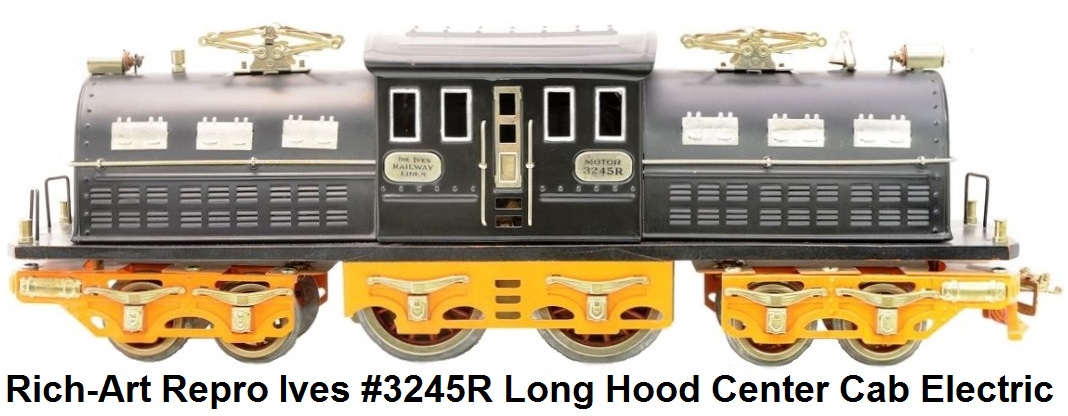 The 1966 Ives reproduction issues were of the Ives transition Model #3245R long cab,
and the Ives 3245R short cab version 4-4-4 electric outline locomotives in Wide gauge originally made
in the late 1920's. These early models were sold and distributed by Varney & Sirus in the 1970's along
with reproduction cars. The engine was offered for separate sale by Rich-Art at $795, or in Olympian
sets with 3, 4 or 5 cars. Another Ives Wide gauge locomotive reproduced by Rich-Art was the #3237
0-4-0 electric outline. It was offered at $600 engine only, or with passenger cars in 3 car sets for
$1700, 4 car sets for $2050 or a 5 car set for $2350.
The 1966 Ives reproduction issues were of the Ives transition Model #3245R long cab,
and the Ives 3245R short cab version 4-4-4 electric outline locomotives in Wide gauge originally made
in the late 1920's. These early models were sold and distributed by Varney & Sirus in the 1970's along
with reproduction cars. The engine was offered for separate sale by Rich-Art at $795, or in Olympian
sets with 3, 4 or 5 cars. Another Ives Wide gauge locomotive reproduced by Rich-Art was the #3237
0-4-0 electric outline. It was offered at $600 engine only, or with passenger cars in 3 car sets for
$1700, 4 car sets for $2050 or a 5 car set for $2350.

 Varney & Sirus had made a reproduction of the Ives Olympian sets,
which were based on American Flyer passenger car bodies but were fitted with Ives trucks and couplers. Rich-Art
used these same dies to produce their own reproduction Ives Olympian set. The cars were 19 inches long and
featured 6-wheel trucks. They were a Club car, Diner, Pullman and Observation. With the addition of some new tooling,
Rich-Art created three new passenger car bodies based on these AF passenger car bodies. These included a baggage
car with 4 baggage doors, an REA car with 4 baggage doors and small windows on one end of the
car, and an RPO car with 4 baggage doors and small windows on both ends of the car. Along with the three unique
body styles, Rich-Art also applied unique paint schemes and unique brass plates to some of their Ives Olympian passenger
sets. These unique Rich-Art cars were painted in the Milwaukee Road's classic tri-color orange, black and maroon
paint scheme. Each car can be identified with a unique Rich-Art 'The Milwaukee Road' or 'Railway Express Agency'
brass plate installed above the small windows, instead of the standard 'Ives Railway Lines' plate.
Rich-Art also installed unique car name and car number plates below the windows in place of the standard Ives plates.
Cars in Standard gauge sold for $350 and cars in #1 gauge for $375.
Varney & Sirus had made a reproduction of the Ives Olympian sets,
which were based on American Flyer passenger car bodies but were fitted with Ives trucks and couplers. Rich-Art
used these same dies to produce their own reproduction Ives Olympian set. The cars were 19 inches long and
featured 6-wheel trucks. They were a Club car, Diner, Pullman and Observation. With the addition of some new tooling,
Rich-Art created three new passenger car bodies based on these AF passenger car bodies. These included a baggage
car with 4 baggage doors, an REA car with 4 baggage doors and small windows on one end of the
car, and an RPO car with 4 baggage doors and small windows on both ends of the car. Along with the three unique
body styles, Rich-Art also applied unique paint schemes and unique brass plates to some of their Ives Olympian passenger
sets. These unique Rich-Art cars were painted in the Milwaukee Road's classic tri-color orange, black and maroon
paint scheme. Each car can be identified with a unique Rich-Art 'The Milwaukee Road' or 'Railway Express Agency'
brass plate installed above the small windows, instead of the standard 'Ives Railway Lines' plate.
Rich-Art also installed unique car name and car number plates below the windows in place of the standard Ives plates.
Cars in Standard gauge sold for $350 and cars in #1 gauge for $375.

In 1985 Rich-Art released a reproduction Ives #1134 4-4-2 steam locomotive and #40 tender in Wide
gauge. It was a brass casting available in copper plated and painted versions with either high or centered headlights.
The motor had bronze axle and gear bearings with a wound field and armature. Over the years it was offered in 4
paint scheme set options. The Prosperity Special set had the copper plated #1134 engine with high headlight,
#40 tender and 3 ($2245), 4 ($2595), or 5 ($2950) matching passenger cars. The Black Diamond set featured a
black enameled #1134 locomotive with high headlight, #40 tender and 3 ($2075), 4 ($2375) or 5 ($2675) black
with red roof passenger cars. The Dorfan set featured a green painted #1134 loco with high headlight, #40 tender,
Dorfan trucks, decals and couplers. It sold for $975. The National Limited set featured a dark red #1134 with
center headlight and matching #40 tender. It also sold for $975.




The next product released by Rich-Art was the model of the Ives Cascade electric Bi-polar
Centipede locomotive #4547. It was available in either Standard gauge or
#1 gauge. The #1 gauge version could run on LGB 2-rail track. The large detailed
electric outline locomotive was powered by double motors and had 16 drivers. Early versions had 4-wheel pilot
trucks. The later versions were equipped with 6-wheel pilot trucks. The early 4-8-8-4 Rich-Art Cascade Bi-Polars were built
using the leftover 4-wheel trucks from the Rich-Art Standard gauge Ives Olympian locos. Since the 4-8-8-4 wheel configuration
was not prototypical, Rich-Art developed 6-wheel trucks for later production Cascade Bi-Polars to match the 6-8-8-6
prototype. It measured 28 inches long and was articulated. It was offered in Olympian black and orange, Milwaukee Road
black, orange and maroon striped, Brooks-Stevens-designed Olympian Hiawatha grey, orange and maroon, and Union Pacific
yellow, red and grey heralds and paint schemes. It was originally priced at $1100 in Standard gauge and $1200 in #1 gauge,
but the price was later reduced to $995. On the Rich-Art Bi-Polar and passenger car sets in 2-rail G gauge, Dick Mayer
installed unique combination G/Standard gauge couplers. Dick grafted the plastic knuckle end of a G scale knuckle coupler
with the metal shaft end of an Ives type coupler. Dick used this basic coupler design on the Rich-Art products he made to
operate on 2-rail G gauge as well as on a few Standard gauge items.

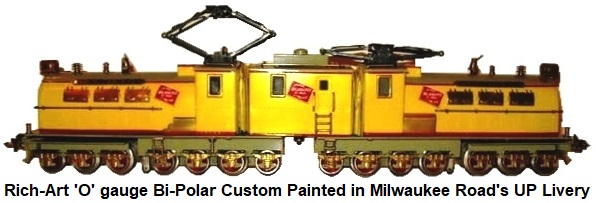 Later came an 'O' gauge version of the bi-polar constructed of all steel and brass
materials and finished with DuPont acrylic enamel paint.
The 'O' gauge Rich-Art Milwaukee Road tin-plate set included the #908 bi-polar Milwaukee Road Cascade engine
powered by two motors (16 Drivers), at 20" long for $895.00 and the #909 matching 6 car Milwaukee Road passenger
consist (orange and black with maroon stripe baggage, club, diner, 2 Pullmans and observation) priced at $700.00.
The cars were 12 inches long and featured 6-wheel trucks. At an additional cost, sets could be ordered in
Union Pacific yellow, red and grey or Hiawatha grey, orange and maroon heralds and paint schemes.
Later came an 'O' gauge version of the bi-polar constructed of all steel and brass
materials and finished with DuPont acrylic enamel paint.
The 'O' gauge Rich-Art Milwaukee Road tin-plate set included the #908 bi-polar Milwaukee Road Cascade engine
powered by two motors (16 Drivers), at 20" long for $895.00 and the #909 matching 6 car Milwaukee Road passenger
consist (orange and black with maroon stripe baggage, club, diner, 2 Pullmans and observation) priced at $700.00.
The cars were 12 inches long and featured 6-wheel trucks. At an additional cost, sets could be ordered in
Union Pacific yellow, red and grey or Hiawatha grey, orange and maroon heralds and paint schemes.


Rich-Art took the Lionel #710 Pullman/#712 Observation 'O' gauge passenger set originally
produced in the 1930's and expanded it to include five cars painted in either blue, orange or red.
This included the #708 Baggage Car, #709 Combine Car, #710 Pullman, #711 Diner and #712 Observation Car.
All were offered for $125 each. The company also produced the Lionel #256 locomotive in all three colors
to match the cars. These sold for $549.95. An entire set of 5 #700 series cars with a matching locomotive
sold for $1100. The blue cars were all equipped with 6-wheel trucks, just as the Lionel originals were, and the
red and orange versions came with 4-wheel trucks, just as the originals were made. These products were initially
developed through a partnership between Art Varney and Dick Wheeler and were later distributed by Bill Doomey.

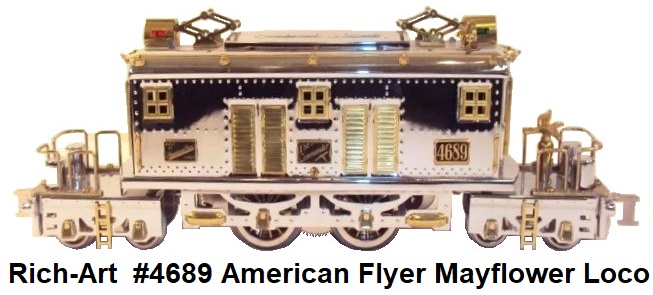
 American Flyer Lines Standard gauge reproductions manufactured by Rich-Art consisted of the President's Special set
#ED501 in 2-toned turquoise blue, the Flying Colonel set in blue, and the Mayflower set in chrome plate. These
sets all featured engines that were made partially utilizing components from the Sirus & Varney Company and a bell-ringer
motor made by the McCoy Manufacturing Co.. The lithographed cars were from new
tooling and were almost identical to the American Flyer originals. The President's Special set featured
a #4689 Commander 4-4-4 electric outline locomotive and 4 passenger cars for $2495.00. The engine
alone was $895. The Flying Colonel set featured a #4686 Ace 4-4-4 electric outline locomotive
with 4 cars for $2275, or 3 cars for $1950. The Mayflower set came with a #4689 4-4-4 locomotive
and 4 cars for $2800, or the loco by itself was offered for $950. Rich-Art also made and sold separate sets
of 19" long Legionnaire cars in buff and green, Hamiltonian cars in two tone red, and Pocahontas cars
in buff and green. These cars were sold separately for $400 each.
Other American Flyer reproductions made by Rich-Art included a Brass Piper Steam Engine with tender, a Brass Piper and
Pocahontas 4 car set, a Vanderbilt tender, a #4006 Hopper and an automatic trackside mail catcher.
American Flyer Lines Standard gauge reproductions manufactured by Rich-Art consisted of the President's Special set
#ED501 in 2-toned turquoise blue, the Flying Colonel set in blue, and the Mayflower set in chrome plate. These
sets all featured engines that were made partially utilizing components from the Sirus & Varney Company and a bell-ringer
motor made by the McCoy Manufacturing Co.. The lithographed cars were from new
tooling and were almost identical to the American Flyer originals. The President's Special set featured
a #4689 Commander 4-4-4 electric outline locomotive and 4 passenger cars for $2495.00. The engine
alone was $895. The Flying Colonel set featured a #4686 Ace 4-4-4 electric outline locomotive
with 4 cars for $2275, or 3 cars for $1950. The Mayflower set came with a #4689 4-4-4 locomotive
and 4 cars for $2800, or the loco by itself was offered for $950. Rich-Art also made and sold separate sets
of 19" long Legionnaire cars in buff and green, Hamiltonian cars in two tone red, and Pocahontas cars
in buff and green. These cars were sold separately for $400 each.
Other American Flyer reproductions made by Rich-Art included a Brass Piper Steam Engine with tender, a Brass Piper and
Pocahontas 4 car set, a Vanderbilt tender, a #4006 Hopper and an automatic trackside mail catcher.

 Rich-Art also created the Toy Train Historical Foundation World War I Set in the early 1990's. This was an armored
military train based on the Lionel #203 Armored train made in 1917. It was a 30 piece 'O' gauge Army train
set offered exclusively for the Toy Train Historical Foundation. The item was offered initially in 3 versions
but was primarily a complete set of trains and accessories that often included a powered locomotive with
gun turret, two flat
cars - one with an airplane and one with an assault cannon, a boxcar, an operating searchlight car,
a troop carrier coach, a gondola with bomb shells, seven doughboy lead soldiers, 12 trench bags, a large tent with flags,
two pup-tents, a 1914 map of Europe, recruitment signs, and an audio cassette tape of authentic WWI battle sounds and
songs from the era. The engine, cars and pieces were made of steel with nickel plating
and were painted in military colors using automotive enamel paint. The tank engine employed a can motor.
Evidently only 300 sets were ever made.
The #ED925 Deluxe Army Set was painted green and tan and came with the tank engine, personnel coach, supply box car,
gondola, flat car with airplane and flat car with assault cannon. It was priced at $315.00.
The #ED926 Collector's Edition Set was gray and
came with the tank engine, 2 supply box cars or personnel cars, and was offered at a price of $225.00. The top
of the line set was the #ED927 Super Set which included the tank engine, supply car, personnel car, flat car
with airplane, flat car with assault cannon, gondola with cannon shells, and a search light car. It was $425.00.
Rich-Art also created the Toy Train Historical Foundation World War I Set in the early 1990's. This was an armored
military train based on the Lionel #203 Armored train made in 1917. It was a 30 piece 'O' gauge Army train
set offered exclusively for the Toy Train Historical Foundation. The item was offered initially in 3 versions
but was primarily a complete set of trains and accessories that often included a powered locomotive with
gun turret, two flat
cars - one with an airplane and one with an assault cannon, a boxcar, an operating searchlight car,
a troop carrier coach, a gondola with bomb shells, seven doughboy lead soldiers, 12 trench bags, a large tent with flags,
two pup-tents, a 1914 map of Europe, recruitment signs, and an audio cassette tape of authentic WWI battle sounds and
songs from the era. The engine, cars and pieces were made of steel with nickel plating
and were painted in military colors using automotive enamel paint. The tank engine employed a can motor.
Evidently only 300 sets were ever made.
The #ED925 Deluxe Army Set was painted green and tan and came with the tank engine, personnel coach, supply box car,
gondola, flat car with airplane and flat car with assault cannon. It was priced at $315.00.
The #ED926 Collector's Edition Set was gray and
came with the tank engine, 2 supply box cars or personnel cars, and was offered at a price of $225.00. The top
of the line set was the #ED927 Super Set which included the tank engine, supply car, personnel car, flat car
with airplane, flat car with assault cannon, gondola with cannon shells, and a search light car. It was $425.00.
 There were a couple of variations of the army set made without all the extras, just the engine and all passenger
cars. One variation was called the Generals set, because the passenger coaches bore the names of great American generals
from both WWI and WWII including names like Pershing, Patton, and MacArthur. Only about twenty-five of these sets were
made and sold in 1992 and 1993. Later on in 1999 during the Kosovo war Rich-Art created 5 unique Soviet military sets
bearing a red star and the names of the cities involved in that war. These sets, consisting of the tank loco, 2 passenger
coaches, a box car and an observation car, were all scooped up at a single meet for $150 each.
There were a couple of variations of the army set made without all the extras, just the engine and all passenger
cars. One variation was called the Generals set, because the passenger coaches bore the names of great American generals
from both WWI and WWII including names like Pershing, Patton, and MacArthur. Only about twenty-five of these sets were
made and sold in 1992 and 1993. Later on in 1999 during the Kosovo war Rich-Art created 5 unique Soviet military sets
bearing a red star and the names of the cities involved in that war. These sets, consisting of the tank loco, 2 passenger
coaches, a box car and an observation car, were all scooped up at a single meet for $150 each.
In the late 1980's, Dick Mayer and his son Bruce bought out Art Varney's interest in Rich-Art.
 Dick Mayer also formed a company called C & M Enterprise.
Lyle Cain, Sr. was the 'C' and Dick Mayer was the 'M' in the 'C & M' partnership. Lyle Cain had been
the sole proprietor of L. C. Enterprises. In the early 1980's, Dick Mayer manufactured and provided the
tooling and parts for replica Lionel Standard gauge gondola containers and the Ives replica of the 1931
water tower to L. C. Enterprises. Subsequently, Cain and Mayer decided to partner up to make a
Toonerville Trolley reproduction. Dick Mayer was the production half of the partnership, while Lyle Cain
had the original idea and obtained permission for the reproduction of the Toonerville Trolley. Toonerville
Folks (aka The Toonerville Trolley That Meets All the Trains) was a popular newspaper cartoon feature created
by Fontaine Fox. The single panel gag cartoon ran from 1908 to 1955. It began in 1908 in the Chicago Post,
and by 1913, it was syndicated nationally. Toonerville was situated in what are now called the suburbs.
Central to the strip was the rickety little trolley called the "Toonerville Trolley that met all the trains,"
driven in a frenzy by the grizzly old Skipper to meet each commuter train as it arrived in town. A few of the
many richly formed characters included the Terrible-Tempered Truman, the Physically Powerful Katrinka,
Little Woo-Woo Wortle, Aunt Eppie Hogg (The Fattest Lady in 3 Counties) and Mickey McGuire, the town bully.
With a lot of assistance from noted train collector and Disney animator Ward Kimball, Mayer and Cain began
tooling operations in June 1986.
Dick Mayer also formed a company called C & M Enterprise.
Lyle Cain, Sr. was the 'C' and Dick Mayer was the 'M' in the 'C & M' partnership. Lyle Cain had been
the sole proprietor of L. C. Enterprises. In the early 1980's, Dick Mayer manufactured and provided the
tooling and parts for replica Lionel Standard gauge gondola containers and the Ives replica of the 1931
water tower to L. C. Enterprises. Subsequently, Cain and Mayer decided to partner up to make a
Toonerville Trolley reproduction. Dick Mayer was the production half of the partnership, while Lyle Cain
had the original idea and obtained permission for the reproduction of the Toonerville Trolley. Toonerville
Folks (aka The Toonerville Trolley That Meets All the Trains) was a popular newspaper cartoon feature created
by Fontaine Fox. The single panel gag cartoon ran from 1908 to 1955. It began in 1908 in the Chicago Post,
and by 1913, it was syndicated nationally. Toonerville was situated in what are now called the suburbs.
Central to the strip was the rickety little trolley called the "Toonerville Trolley that met all the trains,"
driven in a frenzy by the grizzly old Skipper to meet each commuter train as it arrived in town. A few of the
many richly formed characters included the Terrible-Tempered Truman, the Physically Powerful Katrinka,
Little Woo-Woo Wortle, Aunt Eppie Hogg (The Fattest Lady in 3 Counties) and Mickey McGuire, the town bully.
With a lot of assistance from noted train collector and Disney animator Ward Kimball, Mayer and Cain began
tooling operations in June 1986.
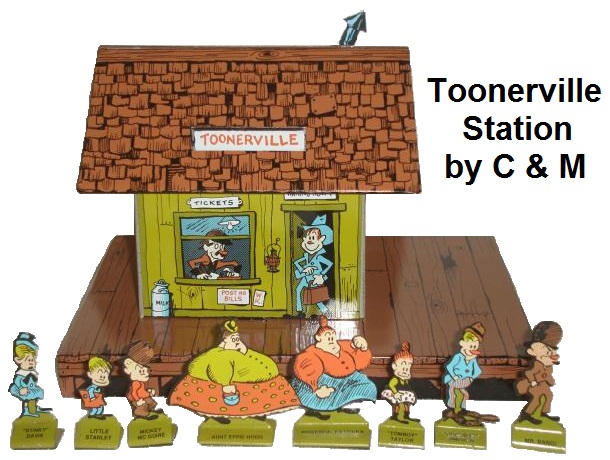 In March of 1987 they took the first 100 'O' gauge models they made to the TCA's York train
show in Pennsylvania and sold them all in the first day. The trolleys were colorful and sported electric
motors and an operating headlight. The body of the new trolley was an exact copy of the old windup floor
models except it featured a new worm drive motor and solid flanged wheels. The wheels were eccentric, so there was a
rocking and up and down motion as the trolley made its way down the track. This wobling movement gave the Skipper
some animation as well. By summer of 2007, they had sold a total
of 2000 'O' gauge, 200 standard gauge and 50 #1 gauge trolleys. Tooling for the HO gauge Toonerville
Trolley was begun in January 1994 and there were originally about 50 produced.
Somewhere in the neighborhood of another 50 were made since then. In September of 1988, again with a
lot of help and assistance from Ward Kimball, they started making the matching Toonerville Depot Set base
building and eight color standup figures to complement the trolley. There were 400 sets sold. The Rich-Art Toonerville
Trolley & accessories product list included the #ED901 Toonerville Trolley in 'O' gauge for $200.00, the
#ED902 Toonerville Trolley in Standard gauge for $250.00, the #ED903 Toonerville Trolley in LGB gauge for $250.00,
the #ED904 Toonerville Depot with figures for $200.00, and the #ED905 Toonerville Double Turntable in 'O' gauge
for $200.00. C & M also produced an Aunt Eppie Hogg Trailer for the trolley, complete with cam and rod operated
bouncing Aunt Eppie Hogg.
In March of 1987 they took the first 100 'O' gauge models they made to the TCA's York train
show in Pennsylvania and sold them all in the first day. The trolleys were colorful and sported electric
motors and an operating headlight. The body of the new trolley was an exact copy of the old windup floor
models except it featured a new worm drive motor and solid flanged wheels. The wheels were eccentric, so there was a
rocking and up and down motion as the trolley made its way down the track. This wobling movement gave the Skipper
some animation as well. By summer of 2007, they had sold a total
of 2000 'O' gauge, 200 standard gauge and 50 #1 gauge trolleys. Tooling for the HO gauge Toonerville
Trolley was begun in January 1994 and there were originally about 50 produced.
Somewhere in the neighborhood of another 50 were made since then. In September of 1988, again with a
lot of help and assistance from Ward Kimball, they started making the matching Toonerville Depot Set base
building and eight color standup figures to complement the trolley. There were 400 sets sold. The Rich-Art Toonerville
Trolley & accessories product list included the #ED901 Toonerville Trolley in 'O' gauge for $200.00, the
#ED902 Toonerville Trolley in Standard gauge for $250.00, the #ED903 Toonerville Trolley in LGB gauge for $250.00,
the #ED904 Toonerville Depot with figures for $200.00, and the #ED905 Toonerville Double Turntable in 'O' gauge
for $200.00. C & M also produced an Aunt Eppie Hogg Trailer for the trolley, complete with cam and rod operated
bouncing Aunt Eppie Hogg.
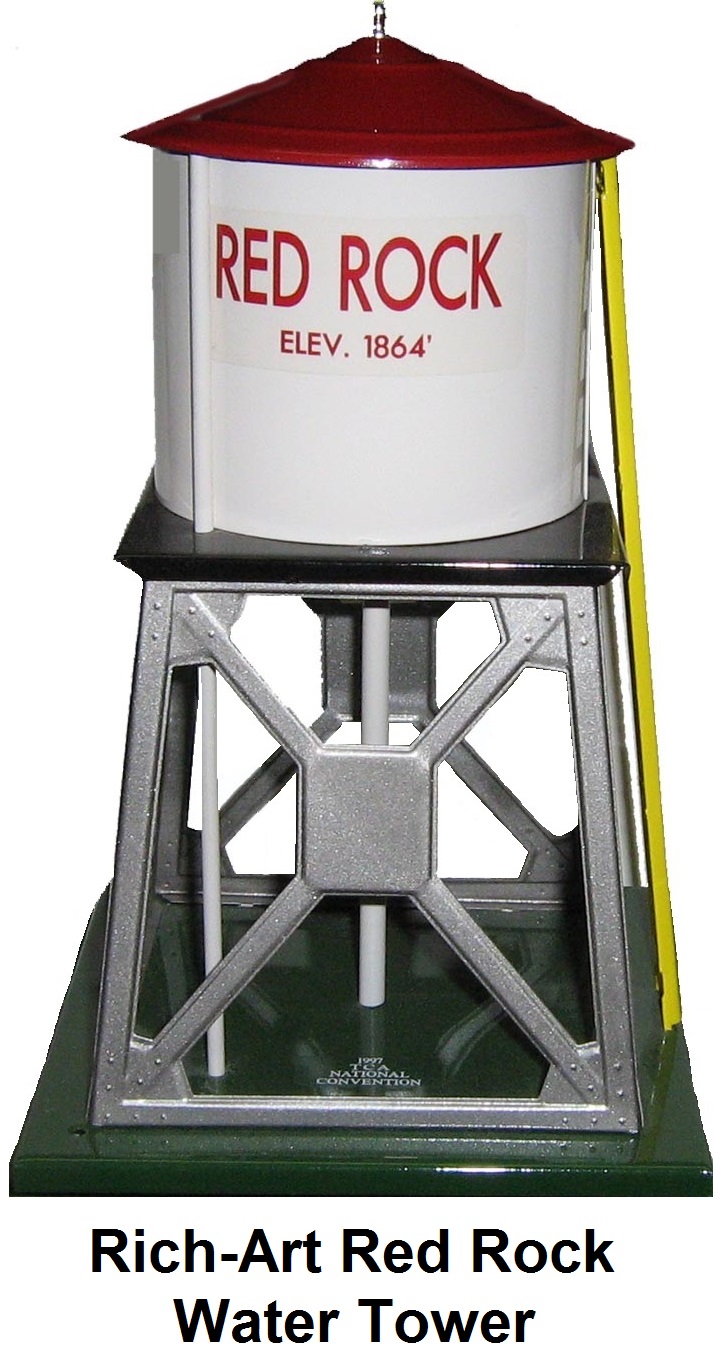 Rich-Art manufactured many items for train clubs. This included the Red rock water
tower which was a model of the water tower at Red Rock, just outside of Marana, Arizona. Rich-Art made a copy
of this icon for the Desert Division of the Train Collectors Association for the 1997 National Convention,
and it was the highest selling TCA Standard gauge offering, ever made.
Rich-Art manufactured many items for train clubs. This included the Red rock water
tower which was a model of the water tower at Red Rock, just outside of Marana, Arizona. Rich-Art made a copy
of this icon for the Desert Division of the Train Collectors Association for the 1997 National Convention,
and it was the highest selling TCA Standard gauge offering, ever made.
Rich-Art also developed several items for the Toy Train Operators Society. The TTOS #87 mining
locomotive and 7-car shorty mining set was one such item. Between 1983 through 1989 a different car was made each year.
These included a Standard gauge 4-wheel fixed bin copper ore hopper made for the 1983 18th National Convention held in
Phoenix, Arizona, a Standard gauge 4-wheel side dump copper ore hopper made for the 1984 Sacramento National
Convention, a Standard gauge 4-wheel side dump blue salt hopper made for the 1985 Snowbird Utah National Convention,
a Standard gauge 4-wheel black flat car with lumber load made for the TTOS in 1986 for the 20th Anniversary
Convention held in Portland, Oregon, a Standard gauge 4-wheel Rochester NY Genesee wooden Ale keg car made
for the TTOS 1987 National Convention, a Standard gauge 4-wheel yellow and orange covered gondola
container car with hinged lids made for the 1988 TTOS Convention held in Tucson, Arizona, and a Standard gauge
4-wheel M-K-T 'The Katy' red tank car made for the 1989 TTOS National Convention. The Mine Train Locomotive
designed to pull the cars was issued in 1986. It featured a can motor linked by a worm gear drive to all four
chain driven drive wheels. The loco sold for $135 if purchased in 1986, but the price went up to $145 afterward.
Initially all the cars made for the conventions were sold out, but Rich-Art later reissued them on a limited
pre-order basis without convention markings, but with the TTOS logo and markings. Reissue cars sold for $30 to $35.
There were also several color variations of the cars, as Rich-Art made limited runs of banquet cars, auction
items or officer recognition cars that had alternative paint schemes, plating and lettering.

Another special item by Rich-Art was the tin-plate Cal-Stewart Cab Stand.
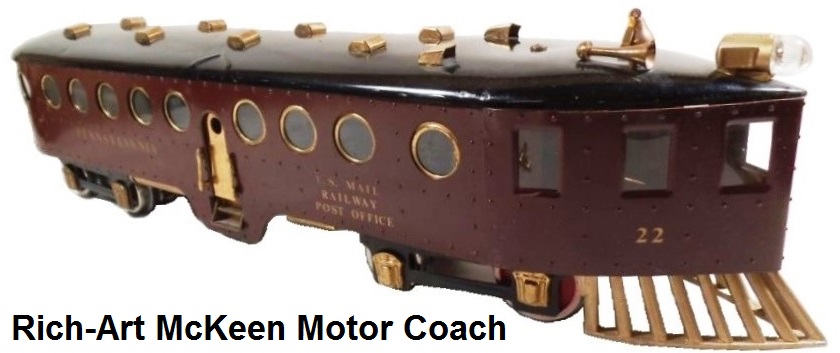 The Rich-Art company produced a tinplate version of the McKeen Motor Car in both Standard
gauge for 3-rail track operation and in #1 gauge for 2-rail track operation. This model was a true rendition of the
short-lived unusual looking prototype motor car with porthole windows that first operated in the early 1900's.
The prototype was built in Omaha, Nebraska and was used on a few lines including as an interurban for the Los Angeles
to San Diego route. The McKeen Motor Cars were the first example of an all steel, self propelled train car design in the
world. They were also the first known use of purposeful aerodynamic design in North America, and the first successful use of
a motive power other than electric or steam, and in being so, they were the lead into the diesel/internal combustion
engine era. A motor car and 3 trailer cars - a baggage, combine and coach were manufactured and sold by Rich-Art.
The power car was driven by a substantial open frame electric motor with chain drive. The power car was 21 inches long.
The sets featured all steel construction, interior cab details and were available in Union Pacific yellow and brown, Santa Fe
green and maroon, Southern Pacific brown and silver, and Virginia & Truckee red and silver paint schemes and heralds.
The motor car sold for $450, and the trailer cars were $175 each. It is estimated that there were less than 100 of
these McKeen Motor cars made by Rich-Art, and thus they have become quite valuable and sought after amongst collectors.
A longer version of the McKeen Motor car was also built by Dick Mayer of Rich-Art for John Bentley in the early 1980's.
In comparison to Dick's short version Mckeen Motor cars, the longer version is around eight inches greater in length and
has an extra cargo/express section added to the power car in front of the passenger compartment. Dick Mayer made only
two long versions of his Rich-Art McKeen motor car. They were the first one he built, and the last one he built.
The first one was his original prototype for the Rich-Art McKeen Motor Car, which he eventually donated to the
Southwestern Division of the Toy Train Operating Society for their use as a fund raiser/door prize at their annual
Cal-Stewart train meet. The longer versions were actually more prototypically to scale length, but Dick realized that
when running these on Standard gauge layouts that the navigation of curves could result in collisions with other trains
running on adjacent tracks or with accessories and trackside structures. So Dick decided to reduce the McKeen Car's
overall length until the underhang became more reasonable.
The Rich-Art company produced a tinplate version of the McKeen Motor Car in both Standard
gauge for 3-rail track operation and in #1 gauge for 2-rail track operation. This model was a true rendition of the
short-lived unusual looking prototype motor car with porthole windows that first operated in the early 1900's.
The prototype was built in Omaha, Nebraska and was used on a few lines including as an interurban for the Los Angeles
to San Diego route. The McKeen Motor Cars were the first example of an all steel, self propelled train car design in the
world. They were also the first known use of purposeful aerodynamic design in North America, and the first successful use of
a motive power other than electric or steam, and in being so, they were the lead into the diesel/internal combustion
engine era. A motor car and 3 trailer cars - a baggage, combine and coach were manufactured and sold by Rich-Art.
The power car was driven by a substantial open frame electric motor with chain drive. The power car was 21 inches long.
The sets featured all steel construction, interior cab details and were available in Union Pacific yellow and brown, Santa Fe
green and maroon, Southern Pacific brown and silver, and Virginia & Truckee red and silver paint schemes and heralds.
The motor car sold for $450, and the trailer cars were $175 each. It is estimated that there were less than 100 of
these McKeen Motor cars made by Rich-Art, and thus they have become quite valuable and sought after amongst collectors.
A longer version of the McKeen Motor car was also built by Dick Mayer of Rich-Art for John Bentley in the early 1980's.
In comparison to Dick's short version Mckeen Motor cars, the longer version is around eight inches greater in length and
has an extra cargo/express section added to the power car in front of the passenger compartment. Dick Mayer made only
two long versions of his Rich-Art McKeen motor car. They were the first one he built, and the last one he built.
The first one was his original prototype for the Rich-Art McKeen Motor Car, which he eventually donated to the
Southwestern Division of the Toy Train Operating Society for their use as a fund raiser/door prize at their annual
Cal-Stewart train meet. The longer versions were actually more prototypically to scale length, but Dick realized that
when running these on Standard gauge layouts that the navigation of curves could result in collisions with other trains
running on adjacent tracks or with accessories and trackside structures. So Dick decided to reduce the McKeen Car's
overall length until the underhang became more reasonable.

Lyle Cain passed away in 1990. By February 2010, Dick Mayer was in the process of closing his shop
and announced in March 2010 that he would not be taking any new orders for products. John Richard “Dick” Mayer
passed away on April 13th 2012. The products of the Rich-Art Company, including the Toy Train Historical Foundation
military set have become more sought after by collectors because of Dick Mayer's passing.
